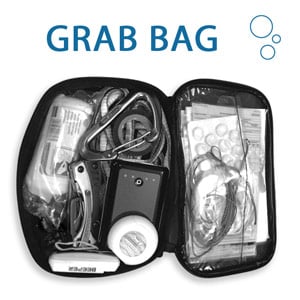
Get ready for adventure with our quick guide to preparing your own grab bag! Paragliders can cover great distances and land in some unexpected locations. Even a gentle evening glide over your favourite forest can end in a surprise. Having some basic survival essentials in your bag can make a big difference. Team pilot Alistair Andrews outlines what should be in your back-country grab bag.
Whether I’m flying from Milk Hill or the Glyders, I keep a little Grab Bag inside the instrument fairing of my harness. Sometimes I tailor it to the extremity of the terrain I might land in, but for normal XC flying it weighs only weighs 670g and fits in a small first aid bag.

The First Aid contents include:
-
Toilet paper - 20 sheets in a waterproof zip seal bag
-
Water purification tablets - really light, stops you getting giardia and other nasties from streams downhill of livestock.
-
Antiseptic wipes, wound dressing, plasters, triangular bandage for broken arms or dislocated joints, Steri-Strips.
-
Bodyglide foot balm (prevents blisters on long walkouts)
-
Small tube of sunblock
-
SPF Lip balm
-
Ibuprofen for pain relief, which also reduces inflammation of joints
-
Immodium – Do I need to explain!?

Other useful items are:
-
Petzl e+lite head torch, 26g – Ideal for late evening walk outs or the dreaded impromptu bivi, should you really end up in the boonies.
-
Gerber Crucial, 150g – Pliers, knife, screw driver, après vol bottle opener.
-
Half roll of black electrical tape, 21g – You can fix (almost) anything with this stuff!
-
Glider repair tape – The sticky stuff that came with the glider manual for jobs that electrical tape just won’t cut.
-
8400mAh USB power pack and short USB cable, 180g –a spare for the phone on the hike or train home.
-
120cm DMM Dyneema Sling, 34g and Lightweight Carabiner, 36g – These are mainly there for securing me to a tree limb if my paraglider and I should end up dangling of an afternoon following an impromptu end to a flight. The sling has other uses; such as a support for a broken arm when looped around the neck, or for tying firewood onto your pack – again, worst case!
-
50m of Oral-B Essentialfloss, 13g – You can’t throw a rope vertically upwards some 30ft, but you can dangle a length of floss then haul it up, before passing it over the limb and securing it to your harness for lowering off. Again it has more uses, like as a drying line for clothes, wind indication when strung from a bush, or even getting that annoying blackberry seed from between your teeth.
-
Various lengths and strengths of paraglider line.
-
Laminated A4 sheet map (in my case, Ben Friedland’s superb Simple Airspace Map for the UK). On the reverse, GLIDER PILOT in large writing, for hitch-hiking.
-
Spare solar vario, 34g.
-
SIS Energy Gel, 60g – The last bit of rations on that long walk out.
-
1 litre of water: often forgotten by XC pilots, and totally essential.

Other than the Grab Bag and maybe a packed lunch, I usually take a pair of Mountain King Trail Blaze trekking poles which weigh 125g each and compact to 30cm. They are a godsend on long hikes (as we see in the X-Alps) and can be used for drying your sodden T -Shirt on top of the hill or supporting a makeshift paraglider tent. I haven’t yet struggled to get them in a harness and simply wrap the rucksack around them before stowing for flight.
Other items? Some useful ideas include:
-
Space Blanket – As in the silver foil ones used by athletes after endurance races.
-
Small Compass
-
List of friends' phone numbers written down and laminated – for when your phone dies and you finally find a pub.
-
Super light poncho - worth considering for unstable days when there may be showers.
-
Anti allergy tablets - for crossing countryside covered in wildflowers and pollen sources.
You have to consider every new item carefully, because there is the potential to end up with a big bag of clobber that you may never use. That said, as a good friend and fan of survival training always says:
“If you’re not always prepared, you’re never prepared”.
I’d recommend tailoring the Grab Bag to your flying area and requirements, but it’s always better to have some useful gear, than just be a victim when landing out. For those nervous of going XC or flying committing lines that may play mind games with you, having some useful survival gear might just give you the confidence you need to clear your mind, go over the back and have an adventure!
.jpg)
^ Tailor your grab bag to suit your environment. Should have packed a beach towel!
Brought to you by Flybubble
Like what we do? The best way to thank and support us is to buy gear from us and recommend us to others. Review our service on Trustpilot and our products on Flybubble Shop. You can also subscribe to Flybubble Patreon. Thank you!

